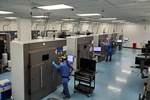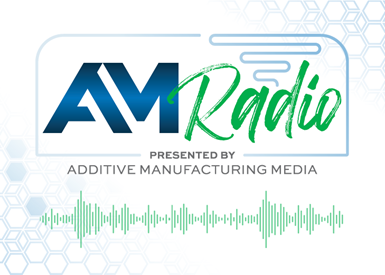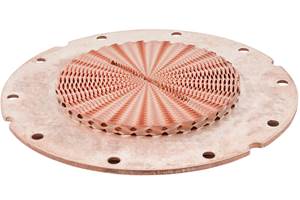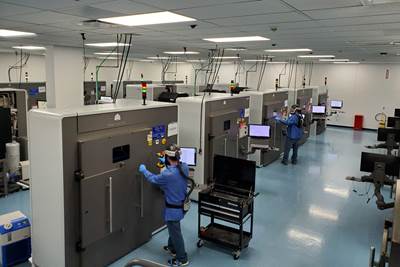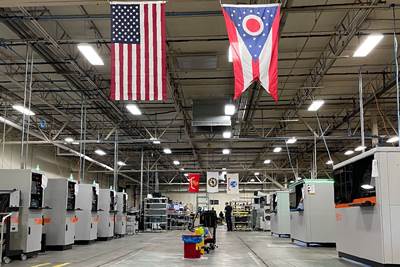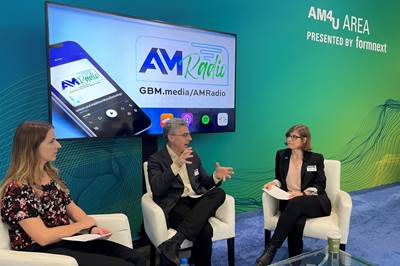The New Misperceptions Of AM: AM Radio #35
Tim Simpson and Peter Zelinski discuss a way additive manufacturing has advanced: The misperceptions have shifted. Knowledge of AM among manufacturers is more sophisticated now. The concerns that inform the perceptions of newcomers have therefore changed.
A sign of the advancing understanding of additive manufacturing: Many of the previous misperceptions have gone away. Or they have at least dramatically declined. Few in manufacturing today believe 3D printing is as simple as “hit print,” and most understand that the design of the part determines how well it can take advantage of AM. However, there are still pervasive misperceptions about AM among the manufacturers today who are just beginning to explore it. Tim Simpson and Peter Zelinski talk about some of the false ideas about additive manufacturing that are in the air and current now. Part of the challenge is simply that AM technology is still changing rapidly; assumptions become invalidated quickly. Tim ends up talking about the pace of this change in additive and what is setting that pace.
Transcript
Peter Zelinski 00:05
How far have manufacturers come in understanding additive? What did they know? What did they still not know? I'm joined by Tim Simpson on this episode of AM Radio.
Stephanie Hendrixson 00:19
This episode of the AM Radio podcast is brought to you by PTXPO, the trade show for North American plastics professionals. Join Additive Manufacturing Media and sister brand Plastics Technology for PTXPO 2023, coming up in March. Find more information at plasticstechnologyexpo.com.
Peter Zelinski 00:40
Welcome, I'm Pete Zelinski of Additive Manufacturing Media. I'm joined by Tim Simpson who is a professor of additive manufacturing at Penn State University. Hi, Tim, how are you doing?
Tim Simpson 00:49
I'm well, Pete, thanks for having me. Great to be back.
Peter Zelinski 00:52
So, Tim, here's what I want to talk about today, I want to talk about what it's like to talk about additive manufacturing to people who are coming to it for the first time. Because in a way, it's something you and I have in common. So I do this in reporting on additive. You do this in consulting on additive and helping companies succeed with it. And at least in my observation, the conversation has changed. There are some things that we used to have to explain we don't anymore. Maybe you see this, too, I guess consulting you do this a lot of different ways. But maybe the longest standing one is as part of the organization you co-lead at Penn State CIMP-3D. Can you talk about that briefly, what it is, what you do there?
Tim Simpson 01:40
Sure, yep, I'm co-director on CIMP-3D, our Center for Innovative Material Processing through Direct Digital Deposition, fancy way of saying we got a bunch of metal 3D printers and get to do cool projects. But we've been up and running over a decade now, have a range of both powder bed fusion and directed energy deposition and binder jetting, and a little bit of everything else. And so we ended up doing a lot of research, both basic and applied with companies, DOD and other organizations trying to help them understand sort of the what, the why and the how of additive manufacturing. And it's been interesting, as you said, over the past 10 years, how much that conversation has changed. And now as well, as I'm working more directly with companies, either through training or consulting on site, again, that conversation certainly has shifted, and I think we've hit an inflection point, you know, within the past one to two years, right, this has evolved to the point where a lot of things that we didn't know, or were uncertain about hadn't been figured out, we do know them. And now it is how do we adopt this? How do we industrialize this? How do we move this into production, whether you're in medical implants, or aerospace parts, or automotive parts? And it's, it is noticeable.
A Podcast About Industrial Additive Manufacturing
AM Radio is an industrial 3D printing podcast that covers topics from bridge production to take-back programs to micro 3D printing to composites...and more.
New episodes publish every 3-4 weeks.
Peter Zelinski
So how do you feel about this, this assertion I'm setting up here, which is that new companies are coming to additive, but what they know has changed and they're still ignorant about some things, too. But are you finding that the conversation with newcomers and new companies considering additive that you're explaining different things than you had to explain in the past?
Tim Simpson
Yeah, I'd agree with that. But then every now and then there is somebody who is just completely ignorant. And you want to say have you been living under a rock for the past decade, I'm sorry, you've seen it? You know, you know what I mean. But yeah, I think certainly the companies that are now sort of getting into the game, they're, they're a bit behind, they're recognizing they're behind. And it's not, you know, what is additive? Or what is this process? Or how do I do it, but it is, hey, my competitor is making great strides with additive because I keep reading about them, you know, how do we catch up? How do we do this? What do I need to know? Right? There's definitely a different level of urgency and understanding there that I think is driving those conversations in, in many cases.
Peter Zelinski 04:15
So I think right there that is an important changed factor that the very earliest adopters had to overcome their ignorance in a vacuum, but successful competitors yeah, that is a very exigent, educational effect on other companies, who are who are reevaluating their own production.
Tim Simpson 04:35
Yeah, I agree, Pete, and I think I always joked in terms of aerospace, right, nobody wanted to be the first to go through qualification and certification with FAA or FDA, you know, pick your certifying body, but at the same time, nobody wants to be third either. Now, I'd say there's a leading company in pretty much every industry that's already figured out how to use additive to get a competitive advantage, add value, save costs, save time, whatever. And exactly as you said, now, the other companies are not in a vacuum anymore, right? It's like, Uh oh, I gotta catch up, or I'm gonna get left even further behind.
Peter Zelinski 05:08
Here's what I'd like to do. So as a way to kind of illustrate the progress that's been made broadly in terms of additive's understanding, let's try to think back to the things that we kept having to explain years ago, or the misconceptions that seemed common place years ago that, except for those companies living under a rock, like you say, are pretty much past now, things that have been broadly overcome. And then maybe after that, we'll get to the misconceptions that are still out there. So like an example of that first group, a misconception I don't think is out there anymore, years ago, not that many years ago, the idea that you would just hit print and a part would appear, and 3D printing was as simple as that. That was out there. That expectation was out there, you probably encountered the same thing.
Tim Simpson 06:02
Absolutely. Right. I think I think we got spoiled by polymer 3D printing. And many of those are just hit print, and you're done. Right? But when it comes to metals, you know, you got to meet those requirements. Physics is still physics, tolerances, GD&T, cost. All those things still exist and have to be met and that requires additional processing, you know, machining, tumbling, finishing heat treat, all this stuff that 10 years ago, we were having to talk through each of these steps with every company versus now I think they realize it, and they're trying to come in and say, well, well, how do I shorten this? Or is there a better way to do this to get to that finished part quicker, better, faster, cheaper, whatever it is, or trying to do?
Peter Zelinski 06:46
Here's another one I think we're over. And less than 10 years ago, I think this was still in the air, the idea that additive was going to take over and that it was going to replace other processes. I have this very vivid memory of an IMTS I was at, International Manufacturing Technology Show and let's say it was 2014. Maybe it might have been 2016. And additive exhibitors at that show, there were a few, it hadn't really become a thing yet, but I saw a pair of attendees at the show. And they were walking near this booth and I heard one nudge his friend and point out the 3D printed parts at the booth there and he said, See that right there. That is what is going to take over for machining. And that person saying that felt very visionary and in the know at the time, but I think, Tim, manufacturers are coming to you now wanting to do additive, and maybe you'd agree, for the most part, they don't come to you thinking that additive is going to take the place fully for what they're doing now.
Tim Simpson 07:56
Yeah, no, I agree. I think yeah, 2013, 2014, right. America Makes had just been sort of formed. There was actually an article in The Economist about how 3D printing is going to take over the world and
Peter Zelinski 08:09
The violin, yeah.
Tim Simpson 08:11
By the 3D printed violin, 3D print your Stratovarius. Right. And there were some claims, like 50% of things are going to be made, you know, by additive and such and such or whatever. So yeah, he's, in the State of the Union speech even, right, President Obama at the time was talking about additive manufacturing. I mean, good lord, it's gonna, this is this is game changing. But then yeah, you look at it now. And you're like, huh, yeah, that was, that was, that was the hype of those inflated expectations for those of you that follow the Gartner Hype Cycle there, that was, we were way up there. And of course, it's been the past 10 years, it was a big, a big fall, level-setting to get to where we are now.
Peter Zelinski 08:52
Absolutely. And additive was and is game changing, but it's not game changing by taking over the whole game board. It's game changing by changing the rules somewhat here and there. And by expanding the size of the board, actually.
Tim Simpson 09:06
No, it's a great, great point. And I think something you said at at IMTS. You know, this year, right? 10 years later, you still look at the footprint of all your additive exhibitors. I mean, it's grown tremendously, but you're still in one small corner of a very, very, very large exhibit of the rest of just machining and manufacturing and oh, casting and everything else, right. So it's growing. And I like your perspective, right? It's it's increasing the board right? New freedoms, new opportunities, it's still not going to replace a lot of those things that are already out there and working just fine.
Peter Zelinski 09:40
Here's another difference from the past and the way people understood additive in the past. DfAM, design for additive manufacturing. We didn't have that term, let alone the acronym that many years ago. The idea that a significant design investment and rethinking of the design from the beginning is necessary to succeed with additive. There was a time almost nobody got that. And I think that's been far better appreciated now.
Tim Simpson 10:10
Yeah, you're hitting close to home on that one for me, I totally agree. Design for manufacturing, right, we've known about for years. And I think this whole notion of having to design for additive manufacturing people were like, Well, wait a minute, if I have all this freedom to make anything, right, then why do we need to design it for this process or that? That's counterintuitive to what everybody is saying. But in reality, just like you have to design for machining and design for casting, you got to design for layer wise fabrication on this process or that, and a lot of companies that would go screen their parts list, pick out this bracket, turn around and try and 3D print it, and then look at it and say, Gosh, why is that so much more expensive to make the same part? It's because you didn't do any of the redesign work for additive like you would have done for any other process. And so there was a disconnect that I think we have, have been able to get over now. And people are certainly coming and saying how do I redesign? How do I modify my part for additive? Or optimize my part to lightweight it or whatever else I would like to do with it?
Peter Zelinski 11:22
Yeah, that's the shift. People aren't coming saying I have this part. Can you make it additively? The question is, how do you, how do you redesign for additive? I remember, a different show a Rapid from years past, it was in my memory. It's the one in Pittsburgh, so maybe it's like 2017, or 2018. But this guy shows up there and he calls out to me, I know him and I've been to his facility. And he does a lot of machining. And he was there at the show. And he had this part in his hand. And it was a lathe part. And he was hoping to find someone who could 3D print it for him. And I think I had just been talking to C&A Tool at the time, and they had plenty of additive capability, you know, and I sort of pointed him there, oh go ask for this person there at that booth. And as he walked away, I sort of thought to myself, I'm not sure I did C&A Tool a favor by sending that guy over to him because he didn't have that in mind. But that that kind of conversation. We don't we don't have that so much anymore.
Tim Simpson 12:23
You're absolutely right. And we've actually put a nuance to it right in the work that I'm doing with, with The Barnes Global Advisors, we differentiate between sort of modifying for additive and designing for additive. And I've, I've written about this in several of my columns as well with you guys over the years, sort of this notion of when you're modifying for additive, you're redesigning it to save cost, how do we reduce postprocessing, reduce material, whatever, you know, minimize support structures? And then we differentiate the design for additive is all of those opportunistic things. How do we lightweight it? How do we lattice it? How do we do this? And and I think we're now at this point where it is more nuanced. And we realized, okay, am I saving cost? Or am I adding value and how do I balance between those two to get to that cost effective, lightweight, topology optimized part that makes sense to 3D print?
Peter Zelinski 13:15
You're transitioning to the thinking now and where we are now. Let's go there next. So I've been sort of looking backwards and thinking about misconceptions we used to face maybe after the break let me hear from you, Tim, some some misconceptions about additive that are still in the air right now and still need to be addressed today.
Stephanie Hendrixson 13:40
This episode of the AM Radio podcast is brought to you by PTXPO, the event for the plastics industry in North America. If your business is involved in plastics processing, mold making or additive manufacturing for plastic parts production, this is the event for you. With more than 100,000 square feet of exhibits, PTXPO offers the latest in plastics technology. Immerse yourself in free educational sessions, experience equipment demonstrations and participate in numerous networking opportunities. PTXPO will connect you with solutions providers who can unlock the right answers for your operation. Join Additive Manufacturing Media and sister brands Plastics Technology and MoldMaking Technology for PTXPO 2023. The event takes place March 28 through 30 in Chicago, Illinois. Find more information about attending, exhibiting or sponsoring this event at plasticstechnologyexpo.com.
Peter Zelinski 14:28
Welcome back. I'm Pete Zelinski. I'm talking to Tim Simpson, professor of additive manufacturing at Penn State. We're talking about misperceptions that manufacturers have about additive when they're initially considering it or starting to take it seriously. There were certain misperceptions that were in the air years ago that really aren't there anymore. We've moved forward even broadly throughout manufacturing in terms of what's understood about additive. But then there are also misperceptions that are still in the air right now and are standing in the way of of additive's adoption, of people seeing the opportunities for it. Let's pick up the conversation there. Tim, where do your thoughts go talking to manufacturers today? What's an example of something they don't quite get if they're not doing additive yet? I think a big one that still irks me quite a bit and sort of this, this notion is, you know, that the processes are not repeatable and reliable. That was perhaps again, 10 years ago, given the knowledge that we had, it was challenging. There was also so much variation, even from one model to the next, right, that it could be, oh, now we've got different gas crossflow going on that causes something different, and there could be differences in machines. But nowadays, the architecture, the systems, you know, they're, they're reliable, and they're steady enough that if you really, as you move to production, you can now understand where those different variations come from, and develop strategies to mitigate them and or inspect for them as your parts are being produced, so that you do get reliable and repeatable processes over and over and over and over again. There are too many manufacturers now doing fairly large-scale, repetitive production with additive to still hold to the idea that this can't be a repeatable process, like Stryker is a striking example of this.
Tim Simpson 16:30
Absolutely. You know, they are cranking out tens to hundreds of 1000s of FDA-approved medical implants. What you can print now with additive, whether it's a knee implant, a hip implant, spinal implant, right, you can only do that with additive. And that's given them a competitive advantage. They figured out how to do this and now other companies are trying to figure out how do we catch up? And how do we differentiate ourselves?
Peter Zelinski 16:58
So the implant makers are a little farther ahead in this and I think of, I think also of RMS Additive in Minnesota, they have a very large-scale implant production process, metal additive, Tangible Solutions in Dayton, they spent quite a while in developing their process, just like you were describing, in identifying all the variables and figuring out how to control for them to get a repeatable process. The implant makers are farther ahead, but in many cases, they have tighter tolerances to meet also than other industries, other industrial sectors ought to be able to hit this pretty handily, given what medical device makers have already achieved.
Tim Simpson 17:37
I agree both of those companies have made great strides in the medical implant industry, right. And that's the challenge you're seeing is, can an existing company, like a Stryker, how do they bring on and onboard and adopt additive versus no, it's got to be a startup, because there's so much inertia, this, that or the other thing, and so you're seeing both of those in all different industries right now going on, both the existing firms that are trying to onboard new technologies, the startups that are in there, certainly. And now of course, things have been evolving enough, mergers and acquisitions are going on that the, the established firms are buying up those smaller startups that have figured this out. To your point, right, you look at what in the aerospace industry, the Airbuses, the Boeings, Lockheeds, GE that are doing this energy production, turbomachinery, space, you know, whether you're a NASA, SpaceX or whoever, I mean, there are additive parts operating on Mars right now in Perseverance actually, in a heat exchanger up there, so they can figure it out, we can get this done. And even these extreme environments that are highly regulated with lots of controls and very tight tolerances, if we can do it there, other companies can figure out other ways of doing this and you're starting to see that.
Peter Zelinski 18:53
Tight tolerances, tight dimensional requirements, but performance requirements related to force and pressure and load, too. Isn't there still this perception out there that parts made in a long established way are inherently stronger than parts made additively?
Tim Simpson 19:10
Oh, that one, that's probably my biggest pet peeve right now is somebody comments says Really? Is it strong enough? Is my additive part as strong? Actually, we were fortunate several years ago in our lab, Ted Reutzel and his team helped the Navy develop the first flight critical part, the V22 link for the Osprey there. I love holding up that part and saying Yep, here it is. These guys figured it out this is as strong as their traditionally made one, so I've joked about it, but you know I want to throw him and hit him in the head with sometimes as well to say yes, it's strong enough it's out there right and either they don't want to believe it that they haven't seen it, they haven't heard about, I mean a lot of people are just heads down these days with all the pressures that are on them. I don't have time to go and read the literature or look at this or this cool story or whatever and so as awesome as your, you know, Cool Parts episodes are right, how many people in all these companies have seen all of those to know all the awesome things that have been going on already?
Peter Zelinski 20:05
Far too few to answer your question. But it's, it's a, it's an interesting aside, because heads down busy. That's the way we all are. That's the way people who are leading significant industrial processes are. And the thing about additive is it's changing faster than the other processes do. So we can't be too critical of the folks who have these misperceptions because they were accurate at one time. It is true that in the past, metal additive machines from machine to machine was not predictably repeatable. And it is true that there was ground for questioning the strength of an additive part in the past. But what I've had to learn about additive, I've been covering manufacturing for decades, and the technology is more stable in other areas, and it leads to a certain consistency of assumptions that you can trust in. But with additive, there is so much change, and an ongoing pace of change to the point that every two years, I'd say, there's cause to step back and question or jettison your assumptions in some significant way. And we're still at the point where we have to keep doing that. And so it means that this ignorance that's out there that we're talking about, in some ways, it's just a necessary catch-up lag, given the rapid pace of change of the technology.
Tim Simpson 21:36
What's interesting that you point that lag out, because being at a university in a research environment, we go through about every two to three years, there's a slew of research projects going on to say, Oh, hey, how can I get fully dense parts? Right? What is the impact of these different process parameters? Oh, now that I can get fully dense parts? How do I make sure they're strong enough with my tensile properties, right, and then that takes three to four years, and then it's like, oh, now let's go to fatigue. Let's go to creep, let's go to this. And so it's natural. I think that, you know, we tend to have a two- or three-year cycle on a research project, to do that investigation to then get the data out there. That then I think, is, is the counterbalance, or is part of the reason in industry, as you said, Hey, every two to two or so years, you should step back and look at well, what were the studies, what was done? What was the new learning that's in there? Because there is new insight, there is new understanding, right?
Peter Zelinski 22:30
That's really fascinating. What you're describing is how academic research in additive manufacturing is still answering fundamental questions. And all those fundamentals have largely been answered for the other processes. And they were answered a long time ago. But there's still basics that we're figuring out and you sort of listed them, porosity, strength, fatigue, creep, and it takes two or three years to validate each one of those things. So we're figuring all this out. And we're getting the reassurance we need, but it's coming in two- to three-year steps.
Tim Simpson 23:04
Yeah, it's interesting. We were fortunate again, in our lab, and we're doing sort of very applied projects, either with the Navy or industry sponsors. But then we're also doing basic research projects funded by National Science Foundation and these other agencies. And I tell you, every time we do an industry project, there's immediately from Yes, we can we can deliver on that. But we uncover two, three or four things where basic fundamental research is needed, right. And so then that becomes fodder for the next proposal to get the next grant to do that work. Because the companies they're moving on, they don't want to fund it. But it's critical. And, you know, I used to joke anytime I lecture within a company, I'd walk away with five or six new PhD topics from the questions that were asked, because it's like, that's a good question. We don't know.
Peter Zelinski 23:55
I want to circle back to a topic you brought up is another misconception that I think is still in the air related to porosity. I think plenty of people still assume that additive parts cannot be fully dense that porosity is an inherent problem to additive parts. Like what do you think about that, Tim? Aren't aren't all additive parts basically colanders?
Tim Simpson 24:16
Oh, yeah, yeah, just sieves, just not gonna hold any pressure whatsoever, just I mean, we were fortunate, we got to get an X-ray computed tomography system years ago, in the lab. And so now with that we can find small pores of micron size scale, right, that we couldn't see before and we certainly didn't care about before. If you were doing casting, that would not have been a concern at all, you know, you'd have gone right ahead to it. And so again, it's this balance of what, what do we know, the newness of the technology, as well as our ability to see and analyze at such a level of detail now, compared to where we were previously that I think just heightens people's concerns whether it's unfounded or not?
Peter Zelinski 25:03
Yeah, the misapprehension that there is a porosity challenge with additive parts leads to searching for more porosity in a way that you wouldn't search with a part made any other way.
Tim Simpson 25:18
Totally agree. And actually we've we've had some work going on Zack Snow one of our Ph. D. students working with Ted Reutzel there, put together an additive manufacturing journal sort of, you know almost a root cause analysis of what are sort of the fixed or known sources of porosity and what are sort of the stochastic ones that are in there. We'll put a copy of that on the resource for this. But we know that now, right, ten years ago, we didn't. But now we do, Oh, powder, X, Y, or Z could be an issue, if I check those, I'm good. Oh, if I'm at my hatch spacing, oh my hatch and my contour don't align, okay, let's check that, right. So it's like, you can now create these checklists. So you can now set up quality control, quality assurance plans for catching those one or two random things that may occur and heightens this fear that I'm not going to be fully dense, my part is going to fail when in reality, no, these are controllable, they're inspectable. Again, we can be repeatable and reliable now much more so than before.
Peter Zelinski 26:16
To be fair, some additive processes do have porosity as a natural outcome, a coarser FDM build, compared to a similar part made through injection molding is going to be a more porous part, gaps between layers. I guess that actually, that suggests to me another, let's call it a misperception. This one's kind of nuanced. But, when people imagine polymer 3D printing, they're imagining an extrusion process, FDM or FFF, when they imagine metal 3D printing they're imagining laser powder bed fusion, those two processes for polymer and metal are sort of the default visualization for what additive is. And one of the misperceptions, I think, is just a lack of awareness of the breadth of all the processes we're talking about when we say additive manufacturing.
Tim Simpson 27:08
Absolutely. Yeah, I think from popularity, right, of material extrusion, whether it's FDM, FFF, you look at all the startups and acquisitions and things, right that you talk plastic, you know, polymer 3D printing, that's the technology you think of. Likewise, when it comes to metals, given the hype, and, you know, hats off again, to GE and their LEAP nozzles, some of these other leaders, right, it's powder bed fusion, but I think actually, there was a great, great paper and a book recently out Paul Gradl, NASA and the team, process selection, right, there's at least ten different ways, using additive to get to a metal part. It's not all powder bed fusion. And certainly when you're doing, you know, rocket nozzles and injectors and these larger scale things, powder bed is not the way to go. And so again, ties back to this, this misconception or misunderstanding that there's only only one way to do metals, there's only one way to do polymers. And both of those have their flaws. But in reality, that's not the case at all anymore.
Peter Zelinski 28:08
I was talking to someone who was working on additive, thinking about additive in the context of the oil and gas industry. And he made that point to me, his team, his group, he said, we spent too much time on powder bed fusion, that, that's a fine process, but we went too far down that road. For our needs, DED can do a lot. And it could give them what they wanted. And they just weren't sufficiently open to all of the options that DED brings just because they had their mindset around one particular option from the beginning.
Tim Simpson 28:39
I agree. And that ties back to some of the training and education aspects that we talked about in an earlier podcast, right is it's process selection, right? You know, when we teach that at a university, I'm going to teach you the processes and then expect you to figure it out versus in industry, you need to think, start with, Hey, why would I select this process versus that and then get into the technology? So there are multiple different ways to go after a metal part or a polymer part or combinations of that that's really critical for companies to know and understand these days.
Peter Zelinski 29:12
We should wrap this up. Can you think of one more quick one, a misperception that's still in the air that you encounter all the time?
Tim Simpson 29:18
I think that so many people think that additive is just too expensive still. There are cases, yes. If, if you're not redesigning your part, as we talked about earlier, then yeah, that's probably going to be more expensive, but you look at cost of materials have come down, you know, 50% or more over the past decade, cost of machines has come down significantly. Of course, productivity of the machines has gone up, multiple lasers and those sorts of aspects they're making them faster, better and cheaper. New technologies that are coming onto the market, right. and so I think this common misconception that it's too expensive, certainly in some industries that may be, but the smart companies have, you know, found or done their Pathfinder or their Demonstration part, they understand what are the different sensitivities to the material cost and the machine costs and these other aspects so they know when to get in the game. If you're just going to sit back and throw your arms up and say it's too expensive. Well, you're going to be left behind.
Peter Zelinski 30:15
We'll leave it there. Tim, thanks for joining me.
Tim Simpson 30:17
Thanks for having me. Great to be here again.
Peter Zelinski 30:19
Thank you for listening to AM Radio. If you like the show, be sure to follow us on your favorite podcast app and leave us a review, give us five stars it really helps us. Speaking of podcasts, I'm in another one as well. Modern Machine Shop's Made in the USA has been dropping a whole new season of episodes. This time we're looking at companies making choices to manufacture in the United States. Find Made in the USA where you get podcasts. We'll be back soon with another episode of AM Radio.
Stephanie Hendrixson 30:47
AM Radio is recorded with help from Austin Grogan. The show is edited by Jodee McElfresh and me, Stephanie Hendrixson. Our artwork is by Kate Bilberry Schrand. AM Radio and Additive Manufacturing Media are products of Gardner Business Media located in the Queen City, Cincinnati, Ohio. I'm Stephanie Hendrixson. Thanks for listening.
Related Content
Additive Manufacturing Is Subtractive, Too: How CNC Machining Integrates With AM (Includes Video)
For Keselowski Advanced Manufacturing, succeeding with laser powder bed fusion as a production process means developing a machine shop that is responsive to, and moves at the pacing of, metal 3D printing.
Read MoreMachine Tool Drawbar Made With Additive Manufacturing Saves DMG MORI 90% Lead Time and 67% CO2 Emission
A new production process for the multimetal drawbar replaces an outsourced plating step with directed energy deposition, performing this DED along with roughing, finishing and grinding on a single machine.
Read More3D Printed Titanium Replaces Aluminum for Unmanned Aircraft Wing Splice: The Cool Parts Show #72
Rapid Plasma Deposition produces the near-net-shape preform for a newly designed wing splice for remotely piloted aircraft from General Atomics. The Cool Parts Show visits Norsk Titanium, where this part is made.
Read MoreWith Electrochemical Additive Manufacturing (ECAM), Cooling Technology Is Advancing by Degrees
San Diego-based Fabric8Labs is applying electroplating chemistries and DLP-style machines to 3D print cold plates for the semiconductor industry in pure copper. These complex geometries combined with the rise of liquid cooling systems promise significant improvements for thermal management.
Read MoreRead Next
AM for Production: Where Conventional Lessons Do and Do Not Apply
As RMS has grown its additive manufacturing division, it has discovered which principles of subtractive manufacturing apply to additive, and which do not.
Read MoreWhen Additive Manufacturing Becomes Business As Usual
Medical implant manufacturer Tangible Solutions has had its share of growing pains to arrive at full-scale production via AM. But now, the company’s challenges are those that any contract manufacturer might recognize.
Read MoreAdditive Manufacturing at IMTS 2022: In the AM Pavilion, and Beyond: AM Radio #26A
Applications and technology for additive manufacturing — not just 3D printing — were widespread across the International Manufacturing Technology Show. Listen to our live discussion recorded during the event for observations on AM at IMTS.
Read More

